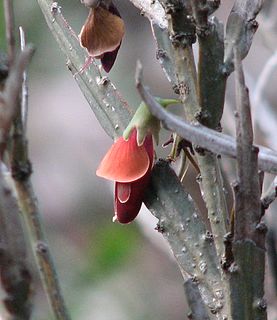
Scaevola is a genus of flowering plants in the Goodenia family, Goodeniaceae. It consists of more than 130 tropical species, with the center of diversity being Australia and Polynesia. There are around 80 species in Australia, occurring throughout the continent. Diversity is highest in the South West, where around 40 species are endemic.

Grevillea is a diverse genus of about 360 species of evergreen flowering plants in the family Proteaceae, native to rainforest and more open habitats in Australia, New Guinea, New Caledonia, Sulawesi and other Indonesian islands east of the Wallace Line. It was named in honour of Charles Francis Greville. The species range from prostrate shrubs less than 50 cm (20 in) tall to trees 35 m (115 ft) tall. Common names include grevillea, spider flower, silky oak and toothbrush plant. Closely related to the genus Hakea, the genus gives its name to the subfamily Grevilleoideae.

Hakea is a genus of about 150 species of plants in the Family Proteaceae and are endemic to Australia. They are shrubs or small trees with leaves that are sometimes flat, otherwise circular in cross section in which case they are sometimes divided. The flowers are usually arranged in groups in leaf axils and resemble those of other genera, especially Grevillea. Hakeas have woody fruit which distinguishes them from grevilleas which have non-woody fruit which release the seeds as they mature. Hakeas are found in every state of Australia with the highest species diversity being found in the south west of Western Australia.

Prostanthera, commonly known as mintbush or mint bush, is a genus of about 100 species of flowering plants of the Lamiaceae, all of which are endemic to Australia. Plants in the genus Prostanthera are usually shrubs, rarely trees with leaves in opposite pairs, flowers arranged in panicles in leaf axils or on the ends of branchlets, the sepals joined at the base with two lobes, the petals usually blue to purple or white, joined in a tube with two "lips", the lower lip with three lobes and the upper lip with two lobes or notched.

Leptomeria is a genus of flowering plants, endemic to Australia. Species include:

Heliotropium is a genus of flowering plants in the borage family, Boraginaceae. There are around 325 species in this almost cosmopolitan genus, which are commonly known as heliotropes. It is highly toxic for dogs and cats.

Exocarpos is a genus of flowering shrubs and small trees in the sandalwood family, Santalaceae. They are found throughout Southeast Asia, Australia and the Pacific Islands.

Cassinia is a large genus of plants in the family Asteraceae, most or all of which are native to the Southern Hemisphere. It was named for French botanist Alexandre de Cassini.

Orites is a genus of 9 known species, 7 endemic to Australia and 2 in South America; 1 in the Chilean Andes and 1 in Bolivia.

Dampiera is a genus of plants in the family Goodeniaceae which are endemic to Australia occurring in all states. They are herbaceous plants or small shrubs which have blue or purple flowers with yellow centres. The genus is named for William Dampier, an English sea captain and scientific observer. Dampiera diversifolia is sometimes grown in gardens as an ornamental.

Calothamnus is a genus of shrubs in the family Myrtaceae and is endemic to the south-west of Western Australia. The common names one-sided bottlebrush or claw flower are given to some species due to their having the flowers clustered on one side of the stem or because of the claw-like appearance of their flowers. Calothamnus species are generally medium to tall woody shrubs with crowded leaves. In most species the leaves are crowded and linear in shape, and the flowers are usually arranged in dense clusters. The petals are small and fall off the flower soon after it opens but the stamens are long, numerous and usually bright red.

Bossiaea is a genus in the pea family (Fabaceae) consisting of about 70 species which are native to Australia. The genus is named in honour of Joseph Hugues Boissieu La Martinière, a botanist on La Pérouse's expedition to Australia.

Maireana is a genus of around 57 species of perennial shrubs and herbs in the family Amaranthaceae which are endemic to Australia. Species in this genus were formerly classified within the genus Kochia. The genus was described in 1840 by the botanist, Moquin-Tandon and named to honour Joseph François Maire (1780-1867), an amateur botanist who befriended him during the author's first visit to Paris in 1834.

Petrophile is a genus of evergreen shrubs, in the family Proteaceae. The genus is endemic to Australia. Commonly known as conebushes, they typically have prickly, divided foliage and produce prominently-displayed pink, yellow or cream flowers followed by grey, conical fruits.

Lasiopetalum is a genus in the family Malvaceae containing around 35 species of shrub, which are native to Australia.

Scleranthus, the knawels, are a genus of herbaceous plants in the family Caryophyllaceae.

Hemigenia is a genus of flowering plants in the mint family, Lamiaceae and is endemic to Australia where most species occur in Western Australia, although some are also found in New South Wales and Queensland. Plants in this genus are shrubs or bushes with simple leaves and tube-shaped flowers with the petals forming two "lips" - the upper one with two lobes and the lower one with three.

Laxmannia is a genus of tufted perennial herbs in the family Asparagaceae, subfamily Lomandroideae, that are endemic to Australia.

Ptilotus obovatus(Gaudich.) F.Muell. is a shrub in the genus Ptilotus R.Br. that occurs in throughout arid Australia. It is commonly known as cotton bush.



















